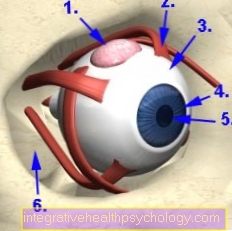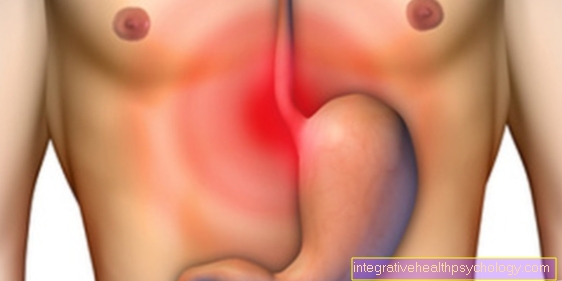Ventilation
Synonyms in the broader sense
Resuscitation, mouth-to-mouth resuscitation, mouth-to-nose resuscitation
English: breathing
Ventilation / airway management
The lightest form of Ventilation in the resuscitation is the "Mouth to mouth" or the "Mouth to nose" Ventilation. The helper blows the exhaled air into the patient's mouth or nose. Accordingly, either the mouth or the nose is then closed to prevent the air from escaping directly. It should also be noted that the head should be overstretched.

The next better option is ventilation Mask ventilation. The patient receives a so-called Guedel tube in the mouth, which prevents the tongue from falling back. Then the head is overstretched and the mask is put on. This encloses the mouth and nose. With the simple method of this ventilation you can now again ventilate with the mouth directly through the mask, but of course the rescue service has resuscitators with which the right amount of air is in the lung is pumped. The bags are also attached to the oxygen cylinder for the best possible use Ventilation to guarantee. Ventilation is very safe with this method, but there is no protection against that Stomach acid runs into the lungs. Therefore there are other methods, e.g. B. intubation.
With ventilation in the form of endotracheal intubation becomes a hose (Tube) in the windpipe pushed and blocked there (attached via an externally inflatable air cushion). That is done by a spatula that Laryngoscope, supported. This is used to hold back the tongue during ventilation and the opening to the windpipe can be seen through the integrated light. The tube can then be connected to the resuscitator. This method is the best known method for keeping the airway clearto ventilate and prevent stomach acid from running into the lungs (aspiration). The aspiration protection is guaranteed by the block. The air cushion completely closes the windpipe so that air can only get into the lungs through the tube.
However, intubation requires a lot of skill and practice on the part of the person performing it. Also in Ambulance service intubate only experienced paramedics or paramedics. Otherwise rather the emergency doctor, but only if he has mastered the measure safely.
That is why there are so-called combination tubes or larynx tubes today. These can be inserted with or without a laryngoscope, i.e. blindly. 98% of them end up in the esophagus. But that doesn't matter, because both tubes have several openings and are also blocked when they are introduced into the esophagus. One opening is at the end of the part that goes into the windpipe and one above the part that goes into the esophagus. So you can ventilate with them, even if they are in the esophagus, and prevent stomach acid from running into the lungs relatively well. Since this type of ventilation is best protected by the endotracheal intubation (see above) is guaranteed, the combination tube or the laryngeal tube is usually removed again in the clinic and then intubated at rest.
If the mouth is swollen shut, for example due to an allergic reaction, you cannot intubate and only insufficiently ventilate with the mask. In this case of ventilation, a coniotomy (tracheal incision) is performed. An incision is made in the windpipe just below the thyroid gland (which sits directly on the windpipe) and a tube is inserted through this incision. This method is very risky due to the proximity of large vessels on the neck and is therefore only carried out in an emergency. However, it is also used in patients who have to be ventilated for a long time. Here, however, the risk is lower because the coniotomy can then be performed under safer conditions. Especially not under time pressure.
Also read that Articles on the topic: First aid
more information on this topic
- resuscitation
- Forms of cardiac arrest
- Resuscitation in children
- Intubation
further interesting information from this area:
- Heart attack
- Cardiac arrhythmia
- Racing heart
- coronary heart disease
- Cardiovascular arrest
- Narrowing of the trachea
You can find an overview of all published topics in this area at: Diseases of the heart











.jpg)





.jpg)











